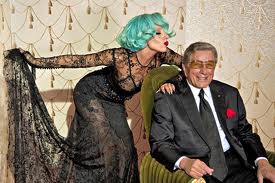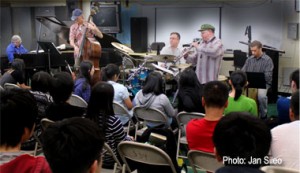The Marlowsphere (#8)
As some of you know, I teach courses in media and culture at Baruch College (City University of New York). Last semester I taught an honors seminar titled “Jazz: Cultural Touchstone of the 20th Century.” This semester I’m about to conclude teaching a course on “Covering the New York Music Scene.” What has been a revelation for me is the constant reporting of some students in class conversation on how much they have disdain for much of today’s over-packaged, superficial content pop music. A couple of students have even reported that they dislike pop/rap/hip-hop music altogether and would rather listen to jazz and other forms of non-pop music.
 The other commentary I hear increasingly from these students is how current rap and hip-hop artists are using music from previous generations in their work. A couple of them have even said: “They’ve run out of ideas. Now they’re going back and using material from 30-40 years ago!” In a way this is not a new approach. In the last few years raw-voiced British rocker Rod Stewart produced and sang on a couple of albums of “standards” from several previous generations ago. In a reverse approach, octogenarian Tony Bennett teamed up with a bevy of contemporary singers, such as Lady Gaga and Amy Winehouse, for his “Duets” albums.
The other commentary I hear increasingly from these students is how current rap and hip-hop artists are using music from previous generations in their work. A couple of them have even said: “They’ve run out of ideas. Now they’re going back and using material from 30-40 years ago!” In a way this is not a new approach. In the last few years raw-voiced British rocker Rod Stewart produced and sang on a couple of albums of “standards” from several previous generations ago. In a reverse approach, octogenarian Tony Bennett teamed up with a bevy of contemporary singers, such as Lady Gaga and Amy Winehouse, for his “Duets” albums.
The “What is old is new again” approach is an “old” way of creating something new. To borrow an example from the literate arts, William Shakespeare based many of his early works on Roman and British History: Julius Caesar, Anthony & Cleopatra, Coriolanus, Richard II, Richard III, all the “Henry” plays, et al. Many blockbuster movies in the last couple of decades are based on “the past” in terms of content, even style: “Dances with Wolves,” “Braveheart,” “Gladiator,” even the more recent black and white, Oscar-winning “The Artist.”
In a way, content from “a long time ago,” so-called “nostalgia material” has great appeal and, dare I say, marketing power. Perhaps you’ve noticed all those “doo-wop” compilation albums for sale on late-night television, and classical albums containing everyone’s favorite “classical melodies.” If Beethoven knew how popular the first movement of his “Moonlight Sonata” was, or his third, fifth, and ninth symphonies were, I wonder what he would say?
But here’s another wrinkle. As I mentioned at the beginning, many of my current journalism students have expressed a dislike from what they feel is the “shallow” music and lyrics purveyed by contemporary artists. Yes, they report on young musicians attempting to make their way in the big, bad world of the music business, and how some of these young musicians are struggling to find their own voice. But these same students seem compelled to listen to music that has passed the test of time. They want to hear music that’s well established.
Is this a reaction to a world increasingly on the brink of chaos? Think Iran, North Korea, increasing competition from Brazil, Russia, India, China (BRICs), housing foreclosures, job growth stagnation, rising costs of education, et al. Yes, today (and tomorrow) there’s plenty of pressure on college students to find a place in the world. There’s no guarantee these days that a college education will result in a well-paying job. Is this all creating an environment where today’s students don’t want, or need to reject the values and music of their parents and create their own world? I’m not certain what the answer is, but I can point to something that re-affirms my view that music that is technically” old can have, and does have appeal to new, young audiences.
 Last week my quintet, The Heritage Ensemble, performed two 40-minute sets at the Bronx High School of Science (see photo right) as part of an outreach concert organized by the New York Composers Circle (NYCC) (FYI, I serve as NYCC’s Membership Director). My ensemble performed my arrangements of several traditional Hebraic melodies and original compositions using various underlying jazz, Afro-Cuban, and Brazilian rhythms. I’m fortunate to have as part of my group multi-Grammy nominee drummer Bobby Sanabria, as well as saxophonist Michael Hashim, bassist Frank Wagner, and (for this particular gig) virtuoso Nuyorican percussionist Matthew Gonzales. These are all superb musicians who can melodically and rhythmically bring the notes I put on the page to life with taste and great virtuosity. BTW, I’m the keyboardist.
Last week my quintet, The Heritage Ensemble, performed two 40-minute sets at the Bronx High School of Science (see photo right) as part of an outreach concert organized by the New York Composers Circle (NYCC) (FYI, I serve as NYCC’s Membership Director). My ensemble performed my arrangements of several traditional Hebraic melodies and original compositions using various underlying jazz, Afro-Cuban, and Brazilian rhythms. I’m fortunate to have as part of my group multi-Grammy nominee drummer Bobby Sanabria, as well as saxophonist Michael Hashim, bassist Frank Wagner, and (for this particular gig) virtuoso Nuyorican percussionist Matthew Gonzales. These are all superb musicians who can melodically and rhythmically bring the notes I put on the page to life with taste and great virtuosity. BTW, I’m the keyboardist.
The more important point in the context of this blog is that the 100 students (and several faculty) we performed for loved what we did. This is what our host Music Director Michael Gasparik said: “Thank you so much for putting on an excellent show for our students. The Heritage Ensemble was fantastic! They really inspired our students tremendously. It was the best performance to come to us in the three years I have worked here. Please feel free to come back anytime.”
Keep in mind this is a student group of freshman to seniors—teenagers who have probably never heard any of the Hebraic melodies and have never heard, up close and personal, any jazz, Afro-Cuban, or Brazilian rhythms. Their response was spontaneous and highly appreciative. In other words, we brought them up in spirit and opened their ears to music from cultures they probably have not been exposed to. To put this in yet another way, content that is seemingly “old” by nature of when it was created is new to a younger generation of listeners.
So, who says “that old stuff” doesn’t have a place? The fact is, what is old can be restored and reinvigorated in new ways if presented with taste, creativity, and authenticity. That nostalgic “old stuff” still has value. What is really new are the young minds and ears listening to it.
Eugene Marlow, Ph.D.
April 29, 2012
© Eugene Marlow 2012

